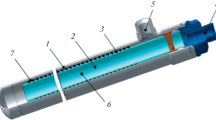Abstract
Models of the process of interaction of pulsed laser radiation with gasdisperse systems are developed. Both individual stages of the process accompanying the interaction of a laser pulse with a gasdisperse system and the dynamics of the state of the system under the conditions of interference of processes of various physical nature are modeled. Generalized dependences allowing prediction of the characteristics of a probing beam are constructed. Boundaries of the region of efficient supply of laser-pulse energy to the system are determined.
Similar content being viewed by others
REFERENCES
V. E. Zuev, Yu. D. Kopytin, and A. V. Kuzikovskii, Nonlinear Optical Effects in Aerosols [in Russian], Nauka, Novosibirsk (1980).
Yu. D. Kopytin, Yu. M. Sorokin, A. M. Skripkin, N. N. Belov, and V. I. Bukatyi, Optical Discharge in Aerosols [in Russian], Nauka, SO AN SSSR, Novosibirsk (1990).
H. Kopecek, H. Maier, G. Reider, F. Winter, and E. Winther, Laser ignition of methane-air mixtures at high pressures, Exp. Thermal Fluid Sci., 27, 499–503 (2003).
I. Yu. Borets-Pervak and V. S. Vorob'ev, Determination of the thresholds of gas breakdown initiated by the interaction of laser radiation with aerosol particles, Kvantovaya Elektron., 20, No.3, 264–270 (1993).
K. N. Volkov, V. N. Emel'yanov, and Li Sulun, Heat and mass transfer in gas-dispersion systems under the intense effect of radiation, in: Proc. IV Minsk Int. Forum “Heat and Mass Transfer-MMF-2000” [in Russian], May 22–26, 2000, Vol. 6, Minsk (2000), pp. 213–222.
K. N. Volkov, V. N. Emel'yanov, and E. L. Ryabova, Two-level modeling of internal two-phase flows, Mat. Modelir., 13, No.7, 44–48 (2001).
K. N. Volkov and V. N. Emel'yanov, Development of heat-and mass-transfer and shock-wave processes in two-phase systems under the effect of intense radiation fluxes, in: Proc. 3rd Russian Nat. Conf. on Heat Transfer [in Russian], Moscow, October 22–25, 2002, Vol. 3, Izd. MEI, Moscow (2002), pp. 242–245.
K. N. Volkov and V. N. Emel'yanov, Interaction of intense radiation fluxes with gasdisperse systems, Mat. Modelir., 15, 35–40 (2003).
V. E. Zuev and V. V. Zuev, Remote Optical Probing of the Atmosphere [in Russian], Gidrometeoizdat, St. Petersburg (1992).
N. I. Koroteev and I. L. Shumai, Physics of High-Power Laser Radiation [in Russian], Nauka, Moscow (1991).
E. S. Shchetinkov, Physics of Combustion of Gases [in Russian], Nauka, Moscow (1965).
V. P. Kolgan, Application of the principle of minimum values of the derivative to construction of finite-difference schemes for calculation of discontinuous solutions of gas dynamics, Uch. Zap. TsAGI, 3, No.6, 68–72 (1972).
Author information
Authors and Affiliations
Additional information
__________
Translated from Inzhenerno-Fizicheskii Zhurnal, Vol. 78, No. 3, pp. 30–37, May–June, 2005.
Rights and permissions
About this article
Cite this article
Volkov, K.N., Emel'yanov, V.N. Prediction of the Characteristics of the Process of Interaction of Pulsed Laser Radiation with Gasdisperse Systems. J Eng Phys Thermophys 78, 440–448 (2005). https://doi.org/10.1007/s10891-005-0079-5
Received:
Issue Date:
DOI: https://doi.org/10.1007/s10891-005-0079-5



